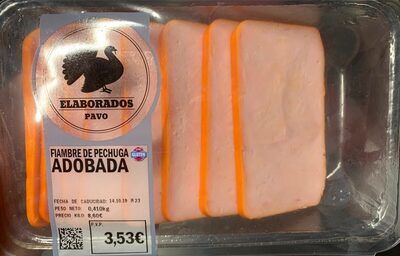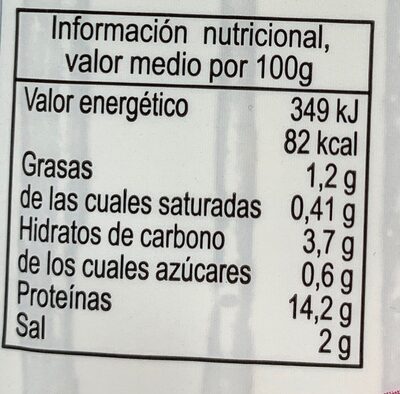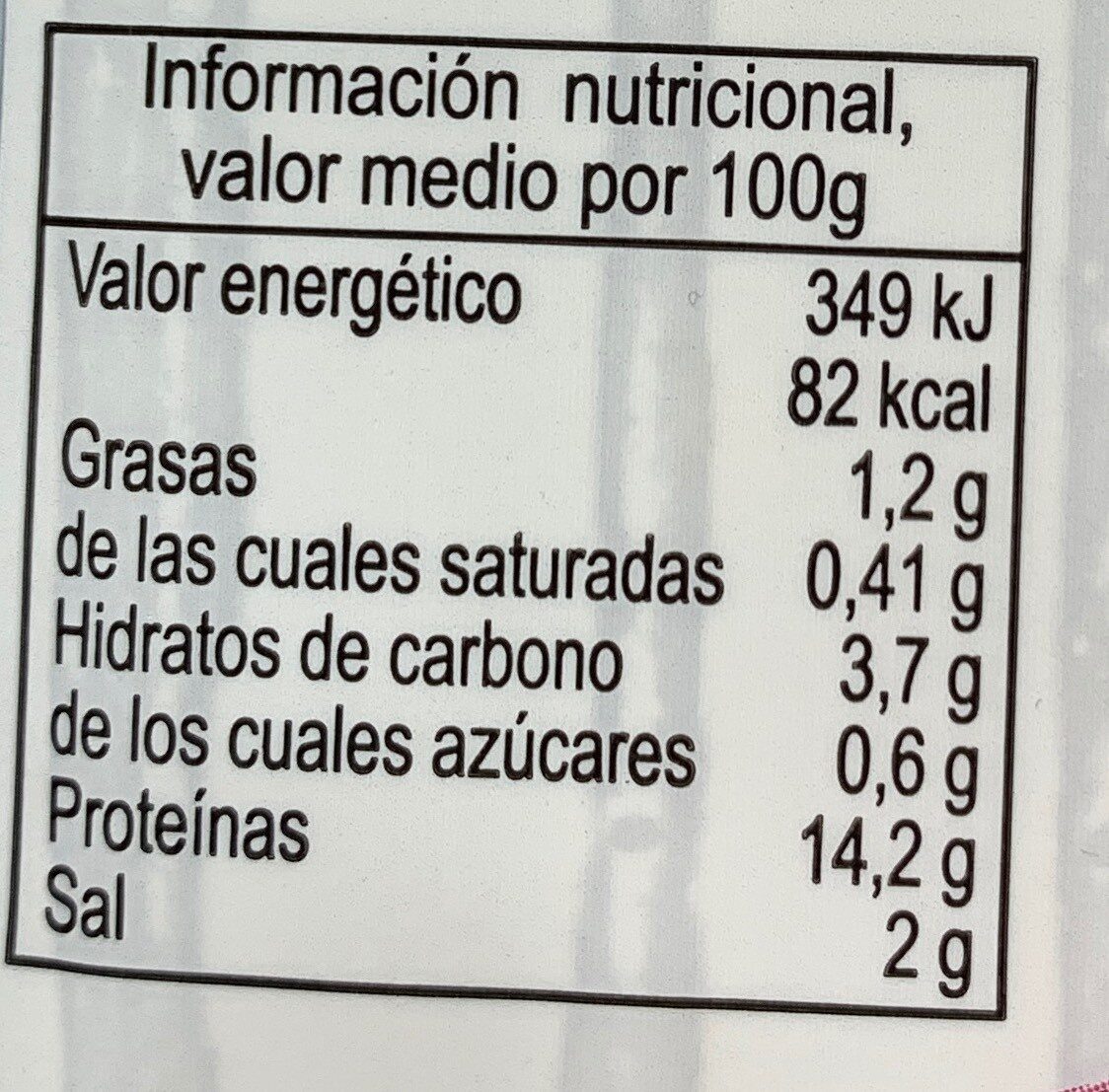Help us make food transparency the norm!
As a non-profit organization, we depend on your donations to continue informing consumers around the world about what they eat.
The food revolution starts with you!
Fiambre de pechuga de pavo adobada - mercadona
Fiambre de pechuga de pavo adobada - mercadona
This product page is not complete. You can help to complete it by editing it and adding more data from the photos we have, or by taking more photos using the app for Android or iPhone/iPad. Thank you!
×
Barcode: 2301879003535 (EAN / EAN-13)
Packaging: Plastic
Brands: Mercadona
Categories: Meats and their products, Meats, Poultries, Turkey and its products, Turkeys
Labels, certifications, awards: No gluten
Manufacturing or processing places: España
Stores: Mercadona
Countries where sold: Spain
Matching with your preferences
Health
Ingredients
-
26 ingredients
: Pechuga de pavo (57%), agua, fécula de patata, proteína de soja, sal, proteína láctea y lactosa (LECHE), regulador de la acidez, (E325), estabilizantes (E450i, E451i, E407), aromas, aroma de humo, antioxidantes (E331, E301), especias, conservador (E250), y colorante (E120), recubrimiento tripa comestible: colorante (E106b).Allergens: Milk, Soybeans
Food processing
-
Ultra processed foods
Elements that indicate the product is in the 4 - Ultra processed food and drink products group:
- Additive: E120 - Cochineal
- Additive: E325 - Sodium lactate
- Additive: E407 - Carrageenan
- Additive: E450 - Diphosphates
- Additive: E451 - Triphosphates
- Ingredient: Colour
- Ingredient: Flavouring
- Ingredient: Lactose
- Ingredient: Milk proteins
Food products are classified into 4 groups according to their degree of processing:
- Unprocessed or minimally processed foods
- Processed culinary ingredients
- Processed foods
- Ultra processed foods
The determination of the group is based on the category of the product and on the ingredients it contains.
Additives
-
E120 - Cochineal
Carminic acid: Carminic acid -C22H20O13- is a red glucosidal hydroxyanthrapurin that occurs naturally in some scale insects, such as the cochineal, Armenian cochineal, and Polish cochineal. The insects produce the acid as a deterrent to predators. An aluminum salt of carminic acid is the coloring agent in carmine. Synonyms are C.I. 75470 and C.I. Natural Red 4. The chemical structure of carminic acid consists of a core anthraquinone structure linked to a glucose sugar unit. Carminic acid was first synthesized in the laboratory by organic chemists in 1991.Source: Wikipedia
-
E250 - Sodium nitrite
Sodium nitrite: Sodium nitrite is the inorganic compound with the chemical formula NaNO2. It is a white to slightly yellowish crystalline powder that is very soluble in water and is hygroscopic. It is a useful precursor to a variety of organic compounds, such as pharmaceuticals, dyes, and pesticides, but it is probably best known as a food additive to prevent botulism. It is on the World Health Organization's List of Essential Medicines, the most important medications needed in a basic health system.Nitrate or nitrite -ingested- under conditions that result in endogenous nitrosation has been classified as "probably carcinogenic to humans" by International Agency for Research on Cancer -IARC-.Source: Wikipedia
-
E301 - Sodium ascorbate
Sodium ascorbate: Sodium ascorbate is one of a number of mineral salts of ascorbic acid -vitamin C-. The molecular formula of this chemical compound is C6H7NaO6. As the sodium salt of ascorbic acid, it is known as a mineral ascorbate. It has not been demonstrated to be more bioavailable than any other form of vitamin C supplement.Sodium ascorbate normally provides 131 mg of sodium per 1‚000 mg of ascorbic acid -1‚000 mg of sodium ascorbate contains 889 mg of ascorbic acid and 111 mg of sodium-. As a food additive, it has the E number E301 and is used as an antioxidant and an acidity regulator. It is approved for use as a food additive in the EU, USA, and Australia and New Zealand.In in vitro studies, sodium ascorbate has been found to produce cytotoxic effects in various malignant cell lines, which include melanoma cells that are particularly susceptible.Source: Wikipedia
-
E325 - Sodium lactate
Sodium lactate: Sodium lactate is the sodium salt of lactic acid, and has a mild saline taste. It is produced by fermentation of a sugar source, such as corn or beets, and then, by neutralizing the resulting lactic acid to create a compound having the formula NaC3H5O3.Source: Wikipedia
-
E331 - Sodium citrates
Sodium citrate: Sodium citrate may refer to any of the sodium salts of citrate -though most commonly the third-: Monosodium citrate Disodium citrate Trisodium citrateThe three forms of the salt are collectively known by the E number E331. Sodium citrates are used as acidity regulators in food and drinks, and also as emulsifiers for oils. They enable cheeses to melt without becoming greasy.Source: Wikipedia
-
E407 - Carrageenan
Carrageenan (E407), derived from red seaweed, is widely employed in the food industry as a gelling, thickening, and stabilizing agent, notably in dairy and meat products.
It can exist in various forms, each imparting distinct textural properties to food.
However, its degraded form, often referred to as poligeenan, has raised health concerns due to its potential inflammatory effects and its classification as a possible human carcinogen (Group 2B) by the International Agency for Research on Cancer (IARC).
Nevertheless, food-grade carrageenan has been deemed safe by various regulatory bodies when consumed in amounts typically found in food.
-
E450 - Diphosphates
Diphosphates (E450) are food additives often utilized to modify the texture of products, acting as leavening agents in baking and preventing the coagulation of canned food.
These salts can stabilize whipped cream and are also found in powdered products to maintain their flow properties. They are commonly present in baked goods, processed meats, and soft drinks.
Derived from phosphoric acid, they're part of our daily phosphate intake, which often surpasses recommended levels due to the prevalence of phosphates in processed foods and drinks.
Excessive phosphate consumption is linked to health issues, such as impaired kidney function and weakened bone health. Though diphosphates are generally regarded as safe when consumed within established acceptable daily intakes, it's imperative to monitor overall phosphate consumption to maintain optimal health.
-
E451 - Triphosphates
Sodium triphosphate: Sodium triphosphate -STP-, also sodium tripolyphosphate -STPP-, or tripolyphosphate -TPP-,- is an inorganic compound with formula Na5P3O10. It is the sodium salt of the polyphosphate penta-anion, which is the conjugate base of triphosphoric acid. It is produced on a large scale as a component of many domestic and industrial products, especially detergents. Environmental problems associated with eutrophication are attributed to its widespread use.Source: Wikipedia
-
E451i - Pentasodium triphosphate
Sodium triphosphate: Sodium triphosphate -STP-, also sodium tripolyphosphate -STPP-, or tripolyphosphate -TPP-,- is an inorganic compound with formula Na5P3O10. It is the sodium salt of the polyphosphate penta-anion, which is the conjugate base of triphosphoric acid. It is produced on a large scale as a component of many domestic and industrial products, especially detergents. Environmental problems associated with eutrophication are attributed to its widespread use.Source: Wikipedia
Ingredients analysis
-
Palm oil free
No ingredients containing palm oil detected
Unrecognized ingredients: es:recubrimiento-tripa-comestible, es:e106bSome ingredients could not be recognized.
We need your help!
You can help us recognize more ingredients and better analyze the list of ingredients for this product and others:
- Edit this product page to correct spelling mistakes in the ingredients list, and/or to remove ingredients in other languages and sentences that are not related to the ingredients.
- Add new entries, synonyms or translations to our multilingual lists of ingredients, ingredient processing methods, and labels.
If you would like to help, join the #ingredients channel on our Slack discussion space and/or learn about ingredients analysis on our wiki. Thank you!
-
Non-vegan
Non-vegan ingredients: Turkey breast, Milk proteins, Lactose, E120Some ingredients could not be recognized.
We need your help!
You can help us recognize more ingredients and better analyze the list of ingredients for this product and others:
- Edit this product page to correct spelling mistakes in the ingredients list, and/or to remove ingredients in other languages and sentences that are not related to the ingredients.
- Add new entries, synonyms or translations to our multilingual lists of ingredients, ingredient processing methods, and labels.
If you would like to help, join the #ingredients channel on our Slack discussion space and/or learn about ingredients analysis on our wiki. Thank you!
-
Non-vegetarian
Non-vegetarian ingredients: Turkey breast, E120Some ingredients could not be recognized.
We need your help!
You can help us recognize more ingredients and better analyze the list of ingredients for this product and others:
- Edit this product page to correct spelling mistakes in the ingredients list, and/or to remove ingredients in other languages and sentences that are not related to the ingredients.
- Add new entries, synonyms or translations to our multilingual lists of ingredients, ingredient processing methods, and labels.
If you would like to help, join the #ingredients channel on our Slack discussion space and/or learn about ingredients analysis on our wiki. Thank you!
-
Details of the analysis of the ingredients
We need your help!
Some ingredients could not be recognized.
We need your help!
You can help us recognize more ingredients and better analyze the list of ingredients for this product and others:
- Edit this product page to correct spelling mistakes in the ingredients list, and/or to remove ingredients in other languages and sentences that are not related to the ingredients.
- Add new entries, synonyms or translations to our multilingual lists of ingredients, ingredient processing methods, and labels.
If you would like to help, join the #ingredients channel on our Slack discussion space and/or learn about ingredients analysis on our wiki. Thank you!
: Pechuga de pavo 57%, agua, fécula de patata, proteína de soja, sal, proteína láctea, lactosa, regulador de la acidez (e325), estabilizantes (e450i, e451i, e407), aromas, aroma de humo, antioxidantes (e331, e301), especias, conservador (e250), y colorante (e120), recubrimiento tripa comestible (colorante (e106b))- Pechuga de pavo -> en:turkey-breast - vegan: no - vegetarian: no - ciqual_food_code: 36301 - percent_min: 57 - percent: 57 - percent_max: 57
- agua -> en:water - vegan: yes - vegetarian: yes - ciqual_food_code: 18066 - percent_min: 2.86666666666667 - percent_max: 43
- fécula de patata -> en:potato-starch - vegan: yes - vegetarian: yes - ciqual_proxy_food_code: 9510 - percent_min: 0 - percent_max: 33.3333333333333
- proteína de soja -> en:soy-protein - vegan: yes - vegetarian: yes - ciqual_food_code: 20591 - percent_min: 0 - percent_max: 20.0666666666667
- sal -> en:salt - vegan: yes - vegetarian: yes - ciqual_food_code: 11058 - percent_min: 0 - percent_max: 13.3777777777778
- proteína láctea -> en:milk-proteins - vegan: no - vegetarian: yes - percent_min: 0 - percent_max: 10.0333333333333
- lactosa -> en:lactose - vegan: no - vegetarian: yes - percent_min: 0 - percent_max: 8.02666666666667
- regulador de la acidez -> en:acidity-regulator - percent_min: 0 - percent_max: 6.68888888888889
- e325 -> en:e325 - vegan: yes - vegetarian: yes - percent_min: 0 - percent_max: 6.68888888888889
- estabilizantes -> en:stabiliser - percent_min: 0 - percent_max: 5.73333333333333
- e450i -> en:e450i - vegan: yes - vegetarian: yes - percent_min: 0 - percent_max: 5.73333333333333
- e451i -> en:e451i - vegan: yes - vegetarian: yes - percent_min: 0 - percent_max: 2.86666666666667
- e407 -> en:e407 - vegan: yes - vegetarian: yes - percent_min: 0 - percent_max: 1.91111111111111
- aromas -> en:flavouring - vegan: maybe - vegetarian: maybe - percent_min: 0 - percent_max: 5
- aroma de humo -> en:smoke-flavouring - vegan: maybe - vegetarian: maybe - percent_min: 0 - percent_max: 4.45925925925926
- antioxidantes -> en:antioxidant - percent_min: 0 - percent_max: 4.01333333333333
- e331 -> en:e331 - vegan: yes - vegetarian: yes - percent_min: 0 - percent_max: 4.01333333333333
- e301 -> en:e301 - vegan: yes - vegetarian: yes - percent_min: 0 - percent_max: 2.00666666666667
- especias -> en:spice - vegan: yes - vegetarian: yes - percent_min: 0 - percent_max: 3.64848484848485
- conservador -> en:preservative - percent_min: 0 - percent_max: 3.34444444444444
- e250 -> en:e250 - vegan: yes - vegetarian: yes - percent_min: 0 - percent_max: 3.34444444444444
- y colorante -> en:colour - percent_min: 0 - percent_max: 3.08717948717949
- e120 -> en:e120 - vegan: no - vegetarian: no - percent_min: 0 - percent_max: 3.08717948717949
- recubrimiento tripa comestible -> es:recubrimiento-tripa-comestible - percent_min: 0 - percent_max: 2.86666666666667
- colorante -> en:colour - percent_min: 0 - percent_max: 2.86666666666667
- e106b -> es:e106b - percent_min: 0 - percent_max: 2.86666666666667
- colorante -> en:colour - percent_min: 0 - percent_max: 2.86666666666667
Nutrition
-
Missing data to compute the Nutri-Score
Missing nutrition facts
⚠ ️The nutrition facts of the product must be specified in order to compute the Nutri-Score.Could you add the information needed to compute the Nutri-Score? Add nutrition facts
-
Nutrient levels
-
Fat in low quantity (1.2%)
What you need to know- A high consumption of fat, especially saturated fats, can raise cholesterol, which increases the risk of heart diseases.
Recommendation: Limit the consumption of fat and saturated fat- Choose products with lower fat and saturated fat content.
-
Saturated fat in low quantity (0.41%)
What you need to know- A high consumption of fat, especially saturated fats, can raise cholesterol, which increases the risk of heart diseases.
Recommendation: Limit the consumption of fat and saturated fat- Choose products with lower fat and saturated fat content.
-
Sugars in low quantity (0.6%)
What you need to know- A high consumption of sugar can cause weight gain and tooth decay. It also augments the risk of type 2 diabetes and cardio-vascular diseases.
Recommendation: Limit the consumption of sugar and sugary drinks- Sugary drinks (such as sodas, fruit beverages, and fruit juices and nectars) should be limited as much as possible (no more than 1 glass a day).
- Choose products with lower sugar content and reduce the consumption of products with added sugars.
-
-
Nutrition facts
Nutrition facts As sold
for 100 g / 100 mlCompared to: Turkeys Energy 1,460 kj
(349 kcal)+185% Fat 1.2 g -57% Saturated fat 0.41 g -49% Carbohydrates 3.7 g +86% Sugars 0.6 g +6% Fiber ? Proteins 14.2 g -32% Salt ? Fruits‚ vegetables‚ nuts and rapeseed‚ walnut and olive oils (estimate from ingredients list analysis) 0 %
Environment
-
Eco-Score D - High environmental impact
⚠ ️Select a country in order to include the full impact of transportation.The Eco-Score is an experimental score that summarizes the environmental impacts of food products.→ The Eco-Score was initially developped for France and it is being extended to other European countries. The Eco-Score formula is subject to change as it is regularly improved to make it more precise and better suited to each country.Life cycle analysis
-
Average impact of products of the same category: C (Score: 41/100)
Category: Turkey, meat and skin, raw
Category: Turkey, meat and skin, raw
- PEF environmental score: 0.71 (the lower the score, the lower the impact)
- including impact on climate change: 5.52 kg CO2 eq/kg of product
Stage Impact Agriculture
82.8 %Processing
10.5 %Packaging
2.5 %Transportation
2.6 %Distribution
1.3 %Consumption
0.3 %
Bonuses and maluses
-
Missing origins of ingredients information
Malus: -5
⚠ ️ The origins of the ingredients of this product are not indicated.
If they are indicated on the packaging, you can modify the product sheet and add them.
If you are the manufacturer of this product, you can send us the information with our free platform for producers.
-
Packaging with a medium impact
Malus: -10
Shape Material Recycling Impact Unknown Plastic High ⚠ ️ The information about the packaging of this product is not sufficiently precise (exact shapes and materials of all components of the packaging).⚠ ️ For a more precise calculation of the Eco-Score, you can modify the product page and add them.
If you are the manufacturer of this product, you can send us the information with our free platform for producers.
Eco-Score for this product
-
Impact for this product: D (Score: 26/100)
Product: Fiambre de pechuga de pavo adobada - mercadona
Life cycle analysis score: 41
Sum of bonuses and maluses: -15
Final score: 26/100
-
Carbon footprint
-
Equal to driving 2.9 km in a petrol car
552 g CO² per 100g of product
The carbon emission figure comes from ADEME's Agribalyse database, for the category: Turkey, meat and skin, raw (Source: ADEME Agribalyse Database)
Stage Impact Agriculture
75.1 %Processing
14.9 %Packaging
5.0 %Transportation
4.2 %Distribution
0.7 %Consumption
0.1 %
Packaging
-
Packaging with a medium impact
-
Packaging parts
(Plastic)
-
Packaging materials
Material % Packaging weight Plastic
-
Transportation
-
Origins of ingredients
Missing origins of ingredients information
⚠ ️ The origins of the ingredients of this product are not indicated.
If they are indicated on the packaging, you can modify the product sheet and add them.
If you are the manufacturer of this product, you can send us the information with our free platform for producers.Add the origins of ingredients for this product Add the origins of ingredients for this product
Report a problem
-
Incomplete or incorrect information?
Category, labels, ingredients, allergens, nutritional information, photos etc.
If the information does not match the information on the packaging, please complete or correct it. Open Food Facts is a collaborative database, and every contribution is useful for all.
Data sources
Product added on by elcoco
Last edit of product page on by roboto-app.
Product page also edited by elcoco.c470aab0d839d8e3c88d2b7b31130e31, kiliweb, musarana, packbot, thaialagata, yuka.WjQxZUYvODhpK0pRdmZJWjl4MzA5czFKMVpXSWZ6bU5ETnNVSWc9PQ.









